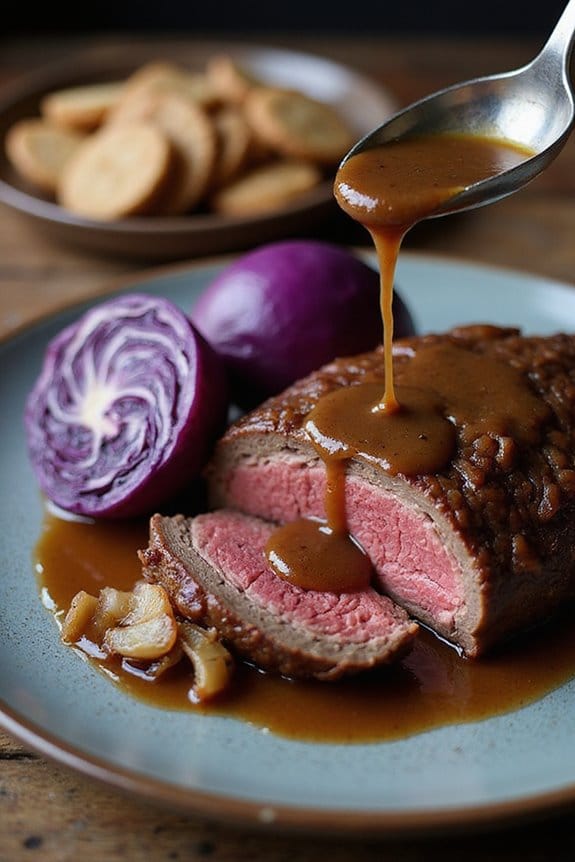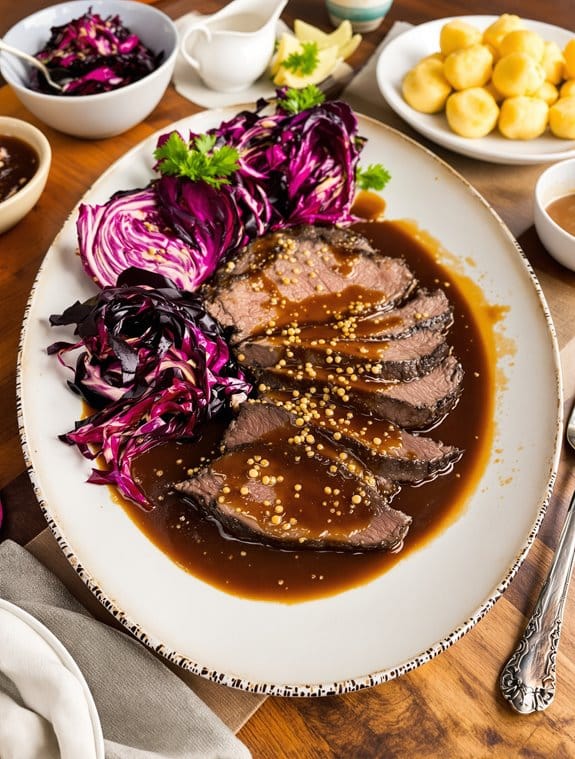Why You’ll Love this Authentic German Sauerbraten
If you’ve never experienced the rich, tangy delight of traditional German Sauerbraten, you’re in for a life-changing culinary adventure.
This isn’t just any pot roast—it’s a labor of love that transforms a humble cut of beef into something magical through days of marination in vinegar, wine, and spices.
I adore how the meat becomes fork-tender while developing complex flavors that simply can’t be rushed.
The gingersnap gravy? Pure genius. Sweet meets savory in a way that perfectly balances the tanginess.
And those cabbage wedges soaking up all that goodness? Heaven on a plate, trust me.
What Ingredients are in Authentic German Sauerbraten?
Authentic German Sauerbraten isn’t just any beef recipe—it’s a time-honored tradition that requires patience and the right ingredients. The magic happens during the multi-day marination process, where the beef slowly transforms in a flavorful bath of vinegar and spices.
What makes this dish so special is how the seemingly simple ingredients work together to create something truly extraordinary. Let me share what you’ll need to recreate this German classic in your own kitchen.
- 3½-4 pounds boneless beef chuck roast
- 6 whole cloves
- 1 cup boiling water
- 2 bay leaves
- 2 teaspoons salt
- 2 onions, sliced into rings
- 1½ cups red wine vinegar
- 12 peppercorns
- 12 juniper berries
- 1 medium head of cabbage, cut into 8 wedges
- 2 tablespoons shortening
- 2 teaspoons sugar
- 12 gingersnap cookies, crushed
While most of these ingredients are fairly common, juniper berries might require a trip to a specialty store or online order. Don’t skip them, though—they provide that distinctive piney flavor that’s quintessentially German.
And those gingersnap cookies? They might seem like an odd addition, but they’re actually the secret ingredient that gives the gravy its velvety texture and subtle sweetness. Can you imagine a more perfect balance to the tangy marinade?
If you can’t find juniper berries, a small amount of gin (which contains juniper) can work in a pinch, though the flavor won’t be quite as authentic.
How to Make this Authentic German Sauerbraten

The beauty of Sauerbraten lies in its traditional preparation method, which begins with a lengthy marination. Start by wiping your 3½-4 pound boneless beef chuck roast with a damp cloth and placing it in a plastic container with a lid.
In a separate bowl, combine 6 whole cloves, 1 cup boiling water, 2 bay leaves, 2 teaspoons salt, 2 sliced onions, 1½ cups red wine vinegar, 12 peppercorns, and 12 juniper berries. This aromatic mixture becomes your marinade—pour it over the meat, cover, and let it work its magic in the refrigerator for 3 to 6 days. Remember to turn the meat twice daily using wooden spoons, never piercing it with a fork (we want to keep all those delicious juices inside).
When the marination period is complete, it’s time to transform this patient project into dinner. Remove the meat from the marinade, but don’t discard that flavorful liquid—we’ll need it later.
Heat 2 tablespoons of shortening in a large skillet and brown the meat slowly on both sides until it develops a rich, caramelized crust. Next, add the reserved marinade to the skillet, cover, and simmer for 2½ to 3 hours until the meat becomes fork-tender. Alternatively, you could transfer everything to a slow cooker and let it cook on low for 6 to 8 hours—perfect for those days when you’d rather not hover over the stove. The most important thing? Don’t overcook it, or you’ll lose that perfect texture we’ve been working toward.
The final steps create that distinctive Sauerbraten experience. Once the meat is tender, remove it along with the onions and keep them warm. Strain the marinade and measure the liquid, adding water if needed to make 2½ cups.
Return this liquid to the skillet and add your cabbage wedges (with toothpicks inserted to hold them together), then cover and simmer for 10 minutes. Now for the signature finishing touch—stir in 12 crushed gingersnap cookies and 2 teaspoons of sugar into the liquid with the cabbage, simmering for at least 3 minutes until you have a velvety gravy.
When serving, arrange the cabbage wedges (toothpicks removed) on a hot platter alongside the meat and onions, with that luscious gingersnap gravy served on the side. The tangy-sweet flavor profile is absolutely worth the wait.
Authentic German Sauerbraten Substitutions and Variations
While traditional recipes hold a special place in culinary history, every German Oma (grandmother) has her own version of Sauerbraten that might differ slightly from the next.
Don’t have juniper berries? Try substituting black peppercorns or allspice berries instead.
No gingersnaps? I’ve used honey cake crumbs or even a mixture of brown sugar and flour in a pinch.
Some regions swap red wine for the vinegar, creating a milder flavor profile.
My mother-in-law uses apple cider vinegar with a touch of balsamic for extra depth.
And honestly, who hasn’t been tempted to shorten that three-day marinade time?
Though, between us, the wait truly makes the difference.
What to Serve with Authentic German Sauerbraten
A perfect German feast demands proper accompaniments for your sauerbraten, transforming this spectacular roast from merely delicious to absolutely memorable.
I always serve mine with spätzle, those delightful little German egg noodles that soak up the rich gingersnap gravy like nothing else. Red cabbage, simmered with apples and a touch of vinegar, provides the perfect tangy contrast.
Don’t forget potato dumplings (kartoffelklöße) or simple boiled potatoes—both traditional choices. For a complete experience, add a cold German pilsner or a glass of Riesling. The combination? Pure comfort food magic, especially on chilly evenings.
Final Thoughts
Beyond those perfect side dishes, German sauerbraten represents something truly special in my culinary heart.
This dish isn’t just about the tender beef or the tangy-sweet gingersnap gravy—it’s about tradition, patience, and transformation.
The magic happens during those days of marinating, when tough chuck roast slowly surrenders to wine vinegar and spices.
Couldn’t we all use a reminder that good things take time?
I’ve shared this recipe with countless friends who’ve made it their own family tradition.
The waiting might test your patience, but trust me, that first bite makes every moment worthwhile.
German comfort food at its finest.

German Sauerbraten
Ingredients
Equipment
Method
- Wipe the beef chuck roast with a damp cloth and place it in a plastic container with a lid.
- In a separate bowl, combine the cloves, boiling water, bay leaves, salt, sliced onions, red wine vinegar, peppercorns, and juniper berries.
- Pour this marinade over the meat, cover, and refrigerate for 3 to 6 days. Turn the meat twice daily using wooden spoons, never piercing it with a fork.
- After marination, remove the meat from the marinade but reserve the liquid for later use.
- Heat the shortening in a large skillet and brown the meat slowly on both sides until it develops a rich, caramelized crust.
- Add the reserved marinade to the skillet, cover, and simmer for 2½ to 3 hours until the meat becomes fork-tender.
- Once the meat is tender, remove it along with the onions and keep them warm.
- Strain the marinade and measure the liquid, adding water if needed to make 2½ cups.
- Return this liquid to the skillet and add the cabbage wedges (with toothpicks inserted to hold them together), then cover and simmer for 10 minutes.
- Stir in the crushed gingersnap cookies and sugar into the liquid with the cabbage, simmering for at least 3 minutes until you have a velvety gravy.
- When serving, arrange the cabbage wedges (toothpicks removed) on a hot platter alongside the meat and onions, with the gingersnap gravy served on the side.



